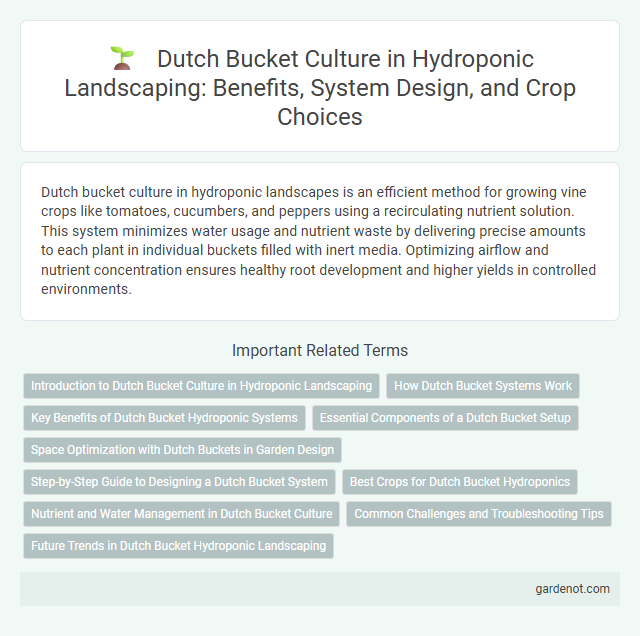Dutch bucket culture in hydroponic landscapes is an efficient method for growing vine crops like tomatoes, cucumbers, and peppers using a recirculating nutrient solution. This system minimizes water usage and nutrient waste by delivering precise amounts to each plant in individual buckets filled with inert media. Optimizing airflow and nutrient concentration ensures healthy root development and higher yields in controlled environments.
Introduction to Dutch Bucket Culture in Hydroponic Landscaping
Dutch Bucket Culture is a widely used hydroponic system designed for growing high-value crops such as tomatoes, peppers, and cucumbers. This technique employs individual buckets filled with an inert growing medium, allowing precise control of nutrient delivery and root aeration. The system optimizes water efficiency and reduces disease risk, making it ideal for sustainable hydroponic landscaping in both commercial and residential applications.
How Dutch Bucket Systems Work
Dutch Bucket systems operate by circulating a nutrient-rich water solution through individual buckets filled with an inert growing medium, such as coconut coir or perlite, supporting each plant. Each bucket includes a drainage hole connected to a return line, allowing excess nutrient solution to flow back to the reservoir for recycling and maintaining optimal moisture levels. This recirculating setup maximizes water efficiency, reduces nutrient waste, and ensures consistent delivery of oxygen and nutrients directly to the root zone for healthy hydroponic crop growth.
Key Benefits of Dutch Bucket Hydroponic Systems
Dutch bucket hydroponic systems offer efficient water and nutrient recirculation, significantly reducing waste and promoting sustainable cultivation. These systems provide excellent root aeration and disease control, enhancing plant health and growth rates. Their modular design supports high-density planting and versatility for crops like tomatoes, peppers, and cucumbers, optimizing space usage in controlled environments.
Essential Components of a Dutch Bucket Setup
A Dutch bucket setup in hydroponic landscaping includes essential components such as individual buckets with drainage holes, a nutrient film circulation system, and a centralized reservoir for nutrient solution storage. Each bucket contains a growing medium like perlite or coconut coir to support plant roots while ensuring proper aeration and moisture retention. The system relies on a consistent flow of nutrient-rich water delivered through drip emitters, promoting optimal growth conditions and minimizing water wastage.
Space Optimization with Dutch Buckets in Garden Design
Dutch bucket culture maximizes space optimization in garden design by enabling vertical stacking and tight row arrangements for hydroponic crops. Each bucket functions as an independent unit with efficient water recirculation, minimizing root competition and allowing high-density planting even in limited areas. This modular system supports diverse crop varieties while enhancing light exposure and airflow, crucial for healthy plant growth in compact hydroponic landscapes.
Step-by-Step Guide to Designing a Dutch Bucket System
Designing a Dutch bucket hydroponic system starts with selecting durable buckets, typically 5-gallon, each equipped with drainage and an aeration setup to ensure proper root oxygenation. Next, arrange the buckets on a stable frame with an appropriate slope for nutrient solution flow to a central reservoir for recirculation. Finally, integrate a reliable pump, tubing, and a filtration system to maintain nutrient delivery and prevent clogging, optimizing plant growth and system efficiency.
Best Crops for Dutch Bucket Hydroponics
Tomatoes, peppers, cucumbers, and eggplants thrive in Dutch bucket hydroponics due to their vine growth habits and nutrient needs. Leafy greens like lettuce and spinach can also perform well, though space per plant may limit yields compared to fruiting crops. Optimal crop selection maximizes space, nutrient efficiency, and overall productivity in Dutch bucket systems.
Nutrient and Water Management in Dutch Bucket Culture
Dutch bucket culture employs a recirculating nutrient solution system that optimizes both water use efficiency and nutrient delivery to plants. Precision in monitoring pH and electrical conductivity (EC) levels ensures balanced nutrient availability, preventing deficiencies and toxicities. Automated irrigation controls adjust water flow based on plant demand, significantly reducing waste and enhancing growth consistency in hydroponic landscapes.
Common Challenges and Troubleshooting Tips
Dutch bucket culture in hydroponic landscaping faces common challenges such as nutrient imbalances, root rot, and uneven water distribution. To troubleshoot, regularly monitor pH levels between 5.5 and 6.5, ensure proper drainage to prevent waterlogging, and maintain consistent water flow using calibrated drip emitters. Inspect roots for signs of disease and adjust nutrient solutions promptly to promote healthy plant growth and optimize yield.
Future Trends in Dutch Bucket Hydroponic Landscaping
Future trends in Dutch bucket hydroponic landscaping emphasize automation and IoT integration to optimize nutrient delivery and water use efficiency. Advances in sensor technology enable real-time monitoring of pH, EC, and moisture levels, reducing resource waste and enhancing plant growth. Sustainable practices, including renewable energy use and biodegradable materials for buckets, are increasingly adopted to minimize environmental impact.
Dutch bucket culture Infographic

 gardenot.com
gardenot.com